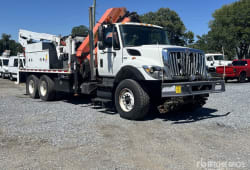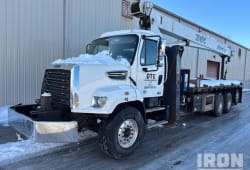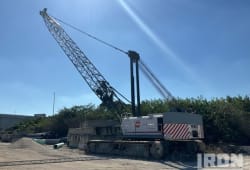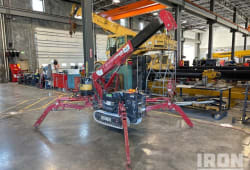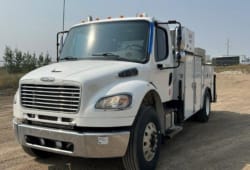How Are Cranes Transported? Things to Know
8 Min read
)
October 7, 2023
Efficient and secure transportation of cranes is a critical factor in the development industry. This process consists of a variety of factors that call for careful attention. These consist of the kind of crane being transported, meticulous schooling, choice of appropriate transportation strategies, stringent protection measures, and the purchase of essential leaves. The intricacies of crane transportation are pivotal in ensuring the seamless and steady motion of those vital production belongings, safeguarding both the tool and the employees worried.
7 Different Types of Cranes and Their Transportation Requirements
Cranes have a sizable spectrum of types, each with notable transportation requirements. Mobile cranes, tower cranes, crawler cranes, hard-terrain cranes, and all-terrain cranes all own particular traits that necessitate specialized delivery answers. Moving those numerous crane types demands an intensive knowledge of their specs and transportation constraints, ensuring they're transported effectively and efficaciously to advent sites wherein their lifting competencies are critical.
Mobile Cranes
Mobile cranes are renowned for their versatility and ease of shipping. They are designed for mobility and may often adventure on highways, making them appropriate for speedy setup at diverse hobby websites. Their capacity to reach and maneuver around places requiring lifting obligations makes them valuable assets inside the construction organization. Mobile cranes are equipped to handle substantial lifting responsibilities, and their accessibility and comfort have solidified their vicinity as vital gear in plenty of advent projects.
Tower Cranes
Tower cranes are frequently utilized to introduce tall homes. Crucial to dealing with heavy masses at extensive heights, these towering giants gift an utterly unique transportation undertaking. Tower cranes must be disassembled into sections for delivery to their region. Once the on-internet site is online, they're meticulously reassembled, often attaining towering heights above the construction web page. These cranes provide the vertical attain essential for developing skyscrapers and tall systems, making them a critical part of cutting-edge city development. The manner of disassembly and reassembly calls for precision and knowledge to ensure their steady and inexperienced operation.
Crawler Cranes
Crawler cranes are renowned for their mobility on rugged terrain, which is the way to their tracked undercarriage. Their potential to navigate uneven ground makes them fundamental for off-street introduction obligations. However, concerning lengthy-distance shipping, these cranes can also require disassembly because of their size and weight. Despite this desire for occasional disassembly, crawler cranes excel when conventional wheeled automobiles might be in warfare, making them profitable belongings in stressful environments where stability and mobility are paramount.
Rough-Terrain Cranes
Rough-terrain cranes are mainly designed for off-road average overall performance, making them best for construction websites with rugged terrain. However, their robust assembly and first-rate weight can present annoying transportation conditions. Due to their bulkiness, cautiously making plans is critical while transporting tough-terrain cranes to and from process websites. This device frequently includes specialized trailers or motors to ensure safe and green transportation. Once on the web page, those cranes display their true worth by offering dependable lifting abilities in rugged environments in which conventional cranes would probably battle to perform efficiently. Their capability to navigate rough terrain makes them valuable property in several advent programs.
All-Terrain Cranes
:format(webp))
All-terrain cranes are prized for their versatility, combining splendid mobility with considerable lifting potential. These cranes can navigate each on-road and rancid avenue terrain, making them treasured for many production responsibilities. However, their period and weight necessitate unique trailers or delivery arrangements. All-terrain cranes are well-perfect for situations where you get the right of entry to the hobby website. Websites can also contain various terrains, from highways to rugged off-avenue locations. Their potential to evolve to precise environments while handing over strong lifting talents positions them as essential assets in production conditions wherein flexibility and strength are crucial.
How to Prepare a Crane for Transport?
Preparing a crane for delivery is a meticulous technique that involves several vital steps. It starts by securing unfastened parts and additives to prevent damage inside the transit route. Thorough inspections are conducted to perceive any gift damage or wear and tear, which can be a hobby earlier than transport. Disassembly can be required when the crane's duration or weight necessitates it. It includes carefully taking apart and securing additives for steady delivery. Proper schooling is critical to ensure the crane arrives at its vacation spot in the only scenario prepared to carry out its essential lifting responsibilities on the improvement internet site.
Choosing the Right Transportation Method for Your Crane
The right transportation method for a crane depends on its kind, period, and the space it wants to journey. Various alternatives are available, and each one is tailored to specific desires. Flatbed trucks are typically used for smaller cranes and shorter distances, while lowboys, with their low deck pinnacle, are first-class for taller cranes and prolonged-distance shipping. Specialized trailers may additionally come into play for extraordinarily big or heavy cranes. Careful attention to these factors ensures that the crane is transported thoroughly and efficaciously, minimizing capacity annoying conditions and risks throughout transit.
Loading and Unloading a Crane
Efficient loading and unloading methods are critical for crane transportation safety and to reduce downtime at creation websites. Loading a crane onto the shipping automobile involves securing it in location and regularly using specialized tools like winches and rigging. Proper weight distribution and balance are essential to save you moving all through transit. Upon arrival on the vacation spot, unloading demands careful execution to make sure the crane is nicely and hastily placed for its intended duties. Competent loading and unloading practices assist in maintaining the crane's integrity, reduce the risk of accidents, and maximize its readiness for advent artwork, improving the usual undertaking overall performance.
Securing a Crane for Transport
Securing a crane for transport is a meticulous device that hinges on using appropriate restraints, braces, and enables. These measures are crucial to prevent any transferring or motion of the crane all through transit, ensuring the protection of the transportation group and the integrity of the crane itself. Properly securing the crane minimizes the hazard of injuries, harm to the machine, and delays in challenge schedules. The meticulous hobby of detailing this aspect of crane transportation is critical, as it contributes substantially to the general protection and overall performance of the method.
Transportation Permits and Regulations
Strict adherence to nearby and national transportation recommendations is paramount while transferring cranes. Depending on the size and weight of the crane, outsized load permits can be crucial. This lets us ensure that the transport complies with street safety and weight limits. Additionally, a few routes may require escorts or pilot motors to guide and alert distinctive motorists to the presence of outsized hundreds. Complying with these guidelines now ensures prison compliance and complements protection by minimizing the threat of accidents or road harm. Proper planning and communication with the transportation government are crucial to constantly letting in and ensuring a clean and lawful delivery method.
Safety Considerations for Transporting Cranes
Safety is the priority for crane transport concerning diverse vital additives. Ensuring proper weight distribution is essential to preserving balance and saving you from instability inside the transit path. Adequate lighting and reflective markers enhance visibility while transporting cranes for low-light situations. Thoughtful direction-making plans are crucial to selecting roads and trails that accommodate the crane's length and weight, even as averting functionality dangers like low bridges or slim passages. Strict adherence to hurry limits and avenue regulations is essential. These safety measures contribute to the constant and incident-loose transportation of cranes, safeguarding every piece of equipment and the proper well-being of those concerned within the shipping approach.
Common Mistakes to Avoid When Transporting Cranes
Transporting cranes demands precision to prevent commonplace errors which can cause injuries and harm. One essential mistake to avoid is inadequate securing; failing to fasten the crane properly can bring about risky shifts during transit. Improper weight distribution can cause instability, impacting protection. Miscalculations in route-making plans, including deciding on roads unsuitable for the crane's duration, pose huge dangers. Additionally, overlooking the need for necessary lets and disregarding transportation guidelines can result in crook troubles and delays. Vigilance in addressing capability pitfalls is crucial to ensure cranes' steady and inexperienced transportation.
Tips for Transporting Cranes Long Distances
Transporting cranes over prolonged distances requires meticulous planning and execution. To make sure a hit journey, several pointers must be observed. Regular rest stops are critical to address riding force fatigue and ensure alertness throughout transit. Frequent preservation checks assist in understanding and dealing with mechanical issues immediately, preventing breakdowns en route. Route optimization is crucial to selecting the most efficient crane-first-rate paths and averting barriers and street risks. Adequate verbal exchange and coordination amongst shipping personnel are essential to address any unforeseen challenges during lengthy distance journeys. These issues contribute to cranes' secure and green transportation over prolonged distances.
Conclusion
Efficient crane transportation is an essential detail of manufacturing responsibilities, impacting their achievement and productivity. It involves careful planning, meticulous interest in pointers, and an unwavering willpower to protect. Proper instruction, securing, and loading/unloading strategies are essential. Acquiring the critical lets in, adhering to transportation policies, and selecting appropriate routes are vital issues. Whether for brief distances or lengthy hauls, adequate crane transportation minimizes downtime, reduces the chance of injuries, and ensures that the crucial creation assets arrive at their vacation spot in a top-of-the-line state of affairs, ready to contribute to the seamless progress of production endeavors.

Rex Walz is Boom & Bucket's Manager of Supplier Relations, bringing over a decade of experience in B2B sales and heavy equipment solutions. With a background spanning government, construction, industrial, and commercial sectors, he has a proven track record of driving growth and building trusted customer relationships. At Boom & Bucket, Rex is passionate about helping partners succeed while advancing the company's mission to create the most trusted marketplace for heavy equipment.



